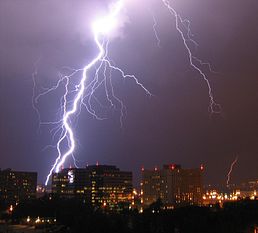
Back Weerlig Afrikaans መብረቅ Amharic चीरिंग ANP برق Arabic ܒܪܩܐ ARC Rayu AST Illapa Aymara Şimşək Azerbaijani Йәшен һәм ялағай Bashkir Tatit BAN
- For the NHL team, see Tampa Bay Lightning
- For the World War II fighter, see P-38 Lightning

Lightning is a very powerful electrical discharge made during a thunderstorm. The electric current makes the air very hot. The suddenly heated air expands very quickly, which causes thunder. Sometimes lightning happens between clouds. Sometimes (in the rain) lightning goes from cloud to ground. If it goes from cloud to ground, it can strike a person. Around 2000 people are struck by lightning each year. A few of them are not killed. About 50 to 100 lightning bolts strike the Earth every second.[1][2] Lightning has hit the Empire State Building as many as 500 times a year. A bolt of lightning can reach temperatures hotter than the surface of the sun.[3]

When lightning strikes, the surface rubs electrons from the lightning, and a spark of electricity shoots from the lightning to the surface. In a thunderstorm, the lower cloud has as many as 100 million volts of electricity.[1] This electricity is given out either within the cloud, to the ground, to another cloud, or into the air. Lightning has been known to travel from the ground upwards to the cloud. In 1993, scientists discovered lightning bolts that shot upward from the top of a cumulonimbus cloud.[1]
People can make and study lightning with a Tesla coil or a Van de Graaff Generator.
- ↑ 1.0 1.1 1.2 Cite error: The named reference
wwas used but no text was provided for refs named (see the help page). - ↑ Cite error: The named reference
britwas used but no text was provided for refs named (see the help page). - ↑ US Department of Commerce, NOAA. "How Hot Is Lightning?". www.weather.gov. Retrieved 2024-09-08.